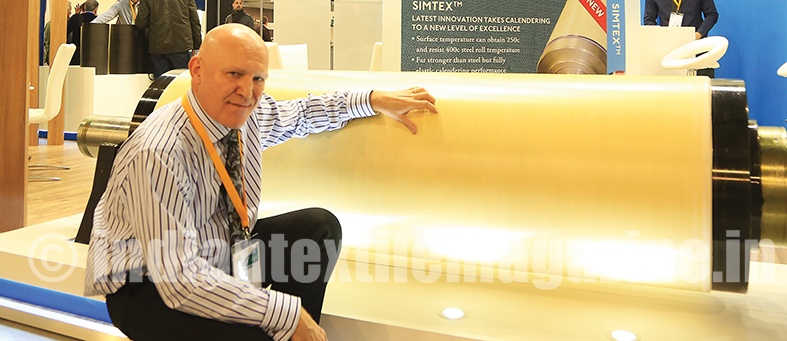Over 30 rolls in operation three years after launch is evidence that Richard Hough has pioneered a novel approach to calendering.

Two years of R&D, three years on the market, and Richard Hough’s innovative Simtex roll is transforming attitudes to calendering across several industrial sectors. Launched to a mainly textile industry audience at the 2015 ITMA machinery exhibition in Milan, the Simtex calender roll has expanded into paper and embossing applications, amassing more than 30 installations since then.
The evidence is clear: all those rolls are still in operation today, with excellent feedback from customers worldwide, and are set to surpass easily the lifespan of rolls made from pressed paper fibres or from composite plastic or polymer materials.
Says Hough MD Anthony Ashton: “Three years is a good time to assess the progress Simtex has made, and to compare its performance over that time with other types of roll cover on the market. Depending on the running conditions, all our installed rolls are on course to run for an incredible minimum of eight times the normal running life of the calender rolls made from fibre or plastics.”
The success of Simtex is rooted in Hough’s unrivalled expertise, gained over 180 years of calender roll manufacture. Using a unique special formulation of high-tech synthetic fibres, Simtex rolls offer exceptional heat resistance and durability. Customers report outstanding results in improved fabric surface quality, as well as optimum value for money through greatly-extended roll longevity.
Hough’s ingenious approach was to combine the best elements of technology from both types of traditional calender rolls. Simtex matches fibre rolls in producing elasticity in the nip (a micro-slip effect that gives improved gloss and smoothness to the fabric surface). At the same time, Simtex takes from plastic rolls the durability and service life arising from the use of cutting-edge new materials.
“The result is probably the most perfect calender roll that has ever been produced,” says Anthony Ashton.
In fact, history shows that many designers of calendering machines were too hasty in ditching ‘old technology’ pressed cotton fibre rolls in the 1990s, opting instead to focus on new all-plastic solutions. Now, after 30 years of further development work, plastic rolls have improved in many respects. However, many of these rolls can still manage only 12 months of heavy calendering use before cracks begin to form, caused by uneven loading. Even a loading variation of just 5% can be enough to destroy a polymer roll.
“We await with interest the reaction to our new Simtex technology from machinery producers whose designs and manufacturing techniques have been based on plastic rolls for the past three decades. The end-users, our customers, are quite ecstatic and their opinions cannot be ignored, says Anthony Ashton.
“It’s becoming clear in many other areas of life that plastics are not always the ideal solution they were once thought to be. As with Simtex, it might well be that traditional methods used in a novel and entrepreneurial way will win out in the end,” he adds.